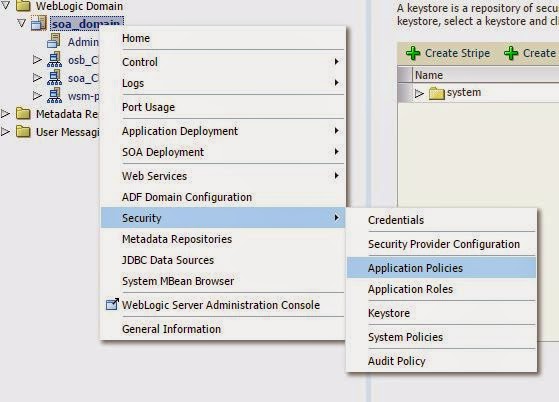In this blog we will go through the steps required to protect a SOA composite service using a basic SAML authentication and message protection.Message protection involves encrypting the message for message confidentiality and signing the message for message integrity. We will be using the predefined OWSM policy "wss11_saml20_token_with_message_protection_service_policy" as our server policy.
By default Messages are protected using WS-Security's Basic 128 suite of symmetric key technologies, specifically RSA key mechanisms for message confidentiality, SHA-1 hashing algorithm for message integrity, and AES-128 bit encryption. If you would like to override any of these defaults take a copy of the policy and override the defaults.The default is to sign and encrypt the entire body for the request the response. You have the option to not do this and to instead specify the specific body elements that you want to sign and encrypt. You can also additionally specify header elements that you want to sign and encrypt.
We have created a simple SOA composite project using mediator which just echoes the request and attached the policy to that.
By default Messages are protected using WS-Security's Basic 128 suite of symmetric key technologies, specifically RSA key mechanisms for message confidentiality, SHA-1 hashing algorithm for message integrity, and AES-128 bit encryption. If you would like to override any of these defaults take a copy of the policy and override the defaults.The default is to sign and encrypt the entire body for the request the response. You have the option to not do this and to instead specify the specific body elements that you want to sign and encrypt. You can also additionally specify header elements that you want to sign and encrypt.
We have created a simple SOA composite project using mediator which just echoes the request and attached the policy to that.
Creating Keystore
For any message protection security policies to work key stores need to be configured which contains the private keys and the certificates associated with those private key.We will be using JKS keystore which is a single OWSM keystore per domain and will be shared by all Web services and clients running in the domain.
For demonstration purpose we will be using keytool to generate a self signed certificate and use it for our configurations.
keytool -genkeypair -v -keypass ******* -storepass oracle123 -alias orakey -keystore mykeystore.jks -keyalg rsa -keysize 2048 -storetype jks -dname 'CN=SOAtest,C=AE' -validity 365
To configure the keystore login to EM > Weblogic Domain >Web service>Security Provider Configuration > Keystore> Configure
Provide the absolute path of the JKS file if it is not kept in the default location and enter the alias for signature key and encryption key and the respective passwords.When OWSM is configured to use the JKS keystore, entries are created in the credential store for the credential map oracle.wsm.security.You must store the password for the decryption key.
Create user in Weblogic
The user in SAML token should be a valid weblogic user. Create the user by logging in to web logic administration console > Security Realms >my realms >Users and Groups and then Users
Server restart is required for the JKS configuration.
Testing the Policy using a Web Service Client
The Web service's base64-encoded public certificate is published in the WSDL for use by the Web service client.Attach a copy of wss11_saml20_token_with_message_protection_client_policy to your Web service client while creating a proxy. Here is a piece of sample code to get started. Tools like TCPMon can be used to intercept requests and see the encryption in action.
public class Execute_ptClient
{
@WebServiceRef
private static Service1 service1;
public static void main(String [] args)
{
service1 = new Service1();
SecurityPoliciesFeature securityFeatures =
new SecurityPoliciesFeature(new String[] { "oracle/wss11_saml20_token_with_message_protection_client_policy" });
Execute_ptt execute_ptt = service1.getExecute_pt(securityFeatures);
Map<String,Object> req=((BindingProvider)execute_ptt).getRequestContext();
req.put(BindingProvider.USERNAME_PROPERTY, "samluser");
req.put(BindingProvider.PASSWORD_PROPERTY, "*******");
req.put(ClientConstants.WSSEC_KEYSTORE_TYPE,"JKS");
req.put(ClientConstants.WSSEC_KEYSTORE_LOCATION, "C:\\op\\cert\\mykeystore.jks");
req.put(ClientConstants.WSSEC_SIG_KEY_ALIAS,"orakey");
req.put(ClientConstants.WSSEC_KEYSTORE_PASSWORD,"*******");
ObjectFactory of=new ObjectFactory();
execute_ptt.execute(new Holder<String>("hi"));
System.out.println("Success");
}
}



